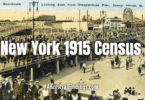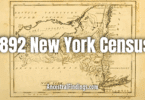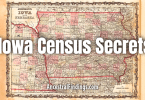The 1940 U.S. Census gives us a remarkably detailed portrait of America just before everything changed. In a few short years, the United States would enter World War II, and millions of lives would be transformed. But in 1940, Americans were still in recovery mode. The Great Depression had taken its toll, but new programs like the New Deal had started to shift the tide. This census captures that fragile balance: a nation still scarred but beginning to look ahead.
This is the most recent census available to the public and, for many genealogists, it’s one of the most informative. It offers a unique combination of traditional questions and new ones that reflect the challenges of the 1930s. As a bridge between the interwar period and the coming conflict, the 1940 census helps us understand where our ancestors stood before everything changed again.
Historical Context of 1940
When enumerators began their work on April 1, 1940, the U.S. population had reached over 132 million. Unemployment had decreased slightly, but the memory of bread lines and dust storms was still fresh. Franklin D. Roosevelt was finishing his second term as president, and federal programs like the Works Progress Administration (WPA) and Civilian Conservation Corps (CCC) had reshaped public life.
Families had moved—some across the country—looking for jobs, stability, or farmland that hadn’t been ravaged by drought. Cities were growing again, and so were suburbs. By 1940, people had begun to believe that things might finally turn around.
You can see those changes in this census. It’s a document shaped by hardship but shaded with hope. It gives us glimpses of families on the move, of new job types, and of economic recovery just starting to take root.
What Was Asked in the 1940 Census?
This census kept many familiar questions, but it also introduced several that were new, making it especially valuable for family historians. Here are some key details recorded:
- Name, relationship to head of household, sex, race, age, marital status.
- Place of birth for each person and their parents.
- Residence on April 1, 1935 (a brand-new feature)—this tells you if someone had moved in the last five years and where they had been living.
- Education level completed.
- Employment status during the week of March 24–30, 1940.
- Income from employment in 1939, measured in dollars.
- Hours worked in the previous week.
- Occupation, industry, and class of worker.
- For women: number of children ever born (only on a special supplemental form for 5% of the population).
- Veteran status and military service.
The question about residence in 1935 is especially helpful when trying to trace family movement during the Great Depression. For example, if someone was living in Oklahoma in 1935 but listed in California in 1940, you may be seeing the results of Dust Bowl migration.
The income question is also fascinating. You can see, for the first time, an ancestor’s actual earnings in 1939. This helps you compare financial stability between family members or understand their social position more clearly.
Research Tips for Using the 1940 Census
Compare 1935 and 1940 locations. This can give you a five-year snapshot of change and show you who stayed put and who moved. It also hints at economic shifts—people relocating for work or leaving areas that had declined.
Pay attention to schooling. Education levels are listed clearly, which can reveal generational shifts. If your ancestor had only an 8th-grade education but their child completed high school or college, that speaks volumes about family priorities and opportunities.
Use occupation and income together. This can help you distinguish between relatives with similar names or narrow down which “John Smith” belongs in your tree.
Check the employment details. If someone worked 0 hours and reported no income, that’s a clue to economic hardship. These data points can also support stories passed down about financial struggles during the Depression years.
Look for supplemental forms. About 5% of respondents were given additional questions, often about fertility (for women), marriage, and Social Security. If your ancestor was one of them, you’ll get even more insight.
Stories Between the Lines
The 1940 census doesn’t record what came next, but we know it. Many of the young men listed here would soon enlist in World War II. Some households would change drastically within just a year or two. This census shows the last full picture before that transformation.
You can often see families forming patterns that hint at what’s ahead. Sons working with their fathers in trades. Daughters taking jobs as stenographers or teachers. Grandparents moving in with adult children. All of this forms a picture of resilience and quiet rebuilding.
This is also one of the first censuses where mass media had truly taken hold. Radios were everywhere, and Americans were more connected than ever before. Though that’s not in the census directly, you can imagine how it shaped the culture your ancestors lived in—the programs they listened to, the news they heard, the shared national experience.
Why the 1940 Census Matters
As the last publicly available federal census, this is where many family history stories pause—at least until 1950. It’s a chance to capture your relatives on the cusp of wartime, in a moment that feels both fragile and full of possibility.
If you’re looking to understand where your family stood in 1940—geographically, financially, educationally, emotionally—this census is a powerful tool. It can confirm family stories, challenge assumptions, and open doors to further research in military and local records.
There’s a stillness to the 1940 census, but not a silence. Look closely, and you’ll see the echoes of everything that came before—and the footsteps of everything that followed.






